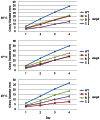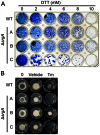Deletion of the sec4 homolog srgA from Aspergillus fumigatus is associated with an impaired stress response, attenuated virulence and phenotypic heterogeneity
- PMID: 23785510
- PMCID: PMC3681910
- DOI: 10.1371/journal.pone.0066741
Deletion of the sec4 homolog srgA from Aspergillus fumigatus is associated with an impaired stress response, attenuated virulence and phenotypic heterogeneity
Abstract
Small GTPases of the Rab family are master regulators of membrane trafficking, responsible for coordinating the sorting, packaging and delivery of membrane-bound vesicles to specific sites within eukaryotic cells. The contribution of these proteins to the biology of the human pathogenic fungus Aspergillus fumigatus has not been explored. In this study, we characterized the srgA gene, encoding a Rab GTPase closely related to Sec4. We found that a GFP-SrgA fusion protein accumulated preferentially at hyphal tips and mature condiophores. The radial growth of a ΔsrgA mutant was impaired on both rich and minimal medium, consistent with a role for SrgA in filamentous growth. In addition, the ΔsrgA mutant revealed dysmorphic conidiophores that produced conidia with heterogeneous morphology. The ΔsrgA mutant was hypersensitive to brefeldin A-mediated inhibition of vesicular trafficking and showed increased temperature sensitivity relative to wild type A. fumigatus. However, the most striking phenotype of this mutant was its phenotypic heterogeneity. Individual colonies isolated from the original ΔsrgA mutant showed variable morphology with colony sectoring. In addition, each isolate of the ΔsrgA mutant displayed divergent phenotypes with respect to thermotolerance, in vitro stress response and virulence in a Galleria mellonella infection model. Taken together, these results indicate that SrgA contributes to the asexual development and filamentous growth of A. fumigatus. However, the discordant phenotypes observed among individual isolates of the ΔsrgA mutant suggest that the absence of srgA exerts selective pressure for the acquisition of compensatory changes, such as second-site suppressor mutations.
Conflict of interest statement
Figures









Similar articles
-
The Putative APSES Transcription Factor RgdA Governs Growth, Development, Toxigenesis, and Virulence in Aspergillus fumigatus.mSphere. 2020 Nov 11;5(6):e00998-20. doi: 10.1128/mSphere.00998-20. mSphere. 2020. PMID: 33177217 Free PMC article.
-
NosA, a transcription factor important in Aspergillus fumigatus stress and developmental response, rescues the germination defect of a laeA deletion.Fungal Genet Biol. 2012 Nov;49(11):857-65. doi: 10.1016/j.fgb.2012.09.005. Epub 2012 Sep 25. Fungal Genet Biol. 2012. PMID: 23022264 Free PMC article.
-
Pleiotropic Effects of the P5-Type ATPase SpfA on Stress Response Networks Contribute to Virulence in the Pathogenic Mold Aspergillus fumigatus.mBio. 2021 Oct 26;12(5):e0273521. doi: 10.1128/mBio.02735-21. Epub 2021 Oct 19. mBio. 2021. PMID: 34663092 Free PMC article.
-
Developmental regulators in Aspergillus fumigatus.J Microbiol. 2016 Mar;54(3):223-31. doi: 10.1007/s12275-016-5619-5. Epub 2016 Feb 27. J Microbiol. 2016. PMID: 26920882 Review.
-
Genetic control of asexual development in aspergillus fumigatus.Adv Appl Microbiol. 2015;90:93-107. doi: 10.1016/bs.aambs.2014.09.004. Epub 2014 Nov 12. Adv Appl Microbiol. 2015. PMID: 25596030 Review.
Cited by
-
The Small GTPase MoSec4 Is Involved in Vegetative Development and Pathogenicity by Regulating the Extracellular Protein Secretion in Magnaporthe oryzae.Front Plant Sci. 2016 Sep 27;7:1458. doi: 10.3389/fpls.2016.01458. eCollection 2016. Front Plant Sci. 2016. PMID: 27729922 Free PMC article.
-
Off the wall: The rhyme and reason of Neurospora crassa hyphal morphogenesis.Cell Surf. 2019 Mar 8;5:100020. doi: 10.1016/j.tcsw.2019.100020. eCollection 2019 Dec. Cell Surf. 2019. PMID: 32743136 Free PMC article. Review.
-
A Rab GTPase protein FvSec4 is necessary for fumonisin B1 biosynthesis and virulence in Fusarium verticillioides.Curr Genet. 2020 Feb;66(1):205-216. doi: 10.1007/s00294-019-01013-6. Epub 2019 Jul 11. Curr Genet. 2020. PMID: 31292685
-
Benzothiourea Derivatives Target the Secretory Pathway of the Human Fungal Pathogen Cryptococcus neoformans.ACS Infect Dis. 2020 Mar 13;6(3):529-539. doi: 10.1021/acsinfecdis.9b00478. Epub 2020 Feb 26. ACS Infect Dis. 2020. PMID: 32070095 Free PMC article.
-
Galleria mellonella as a screening tool to study virulence factors of Aspergillus fumigatus.Virulence. 2021 Dec;12(1):818-834. doi: 10.1080/21505594.2021.1893945. Virulence. 2021. PMID: 33682618 Free PMC article. Review.
References
-
- Momany M (2002) Polarity in filamentous fungi: establishment, maintenance and new axes. Curr Opin Microbiol 5: 580–585. - PubMed
-
- Riquelme M, Yarden O, Bartnicki-Garcia S, Bowman B, Castro-Longoria E, et al. (2011) Architecture and development of the Neurospora crassa hypha – a model cell for polarized growth. Fungal Biol 115: 446–474. - PubMed
-
- Wosten HA, Moukha SM, Sietsma JH, Wessels JG (1991) Localization of growth and secretion of proteins in Aspergillus niger . J Gen Microbiol 137: 2017–2023. - PubMed
-
- Moukha SM, Wosten HA, Asther M, Wessels JG (1993) In situ localization of the secretion of lignin peroxidases in colonies of Phanerochaete chrysosporium using a sandwiched mode of culture. J Gen Microbiol 139: 969–978. - PubMed
Publication types
MeSH terms
Substances
Grants and funding
LinkOut - more resources
Full Text Sources
Other Literature Sources
Molecular Biology Databases

